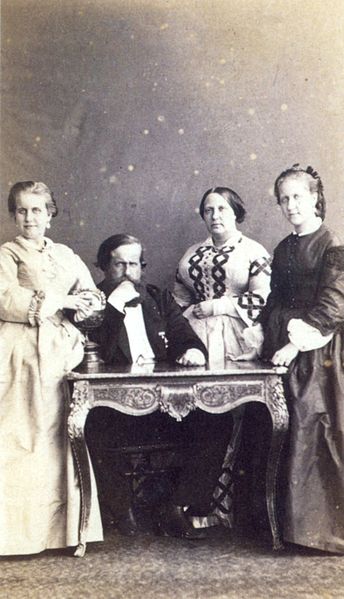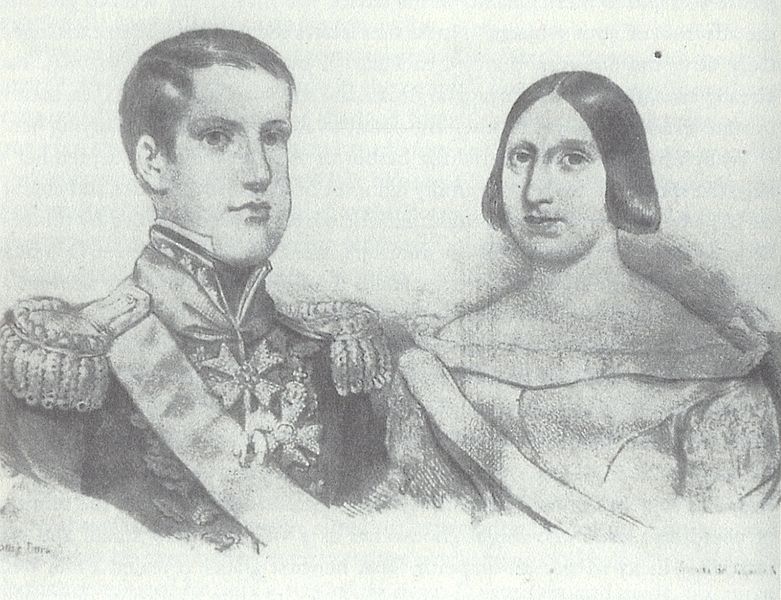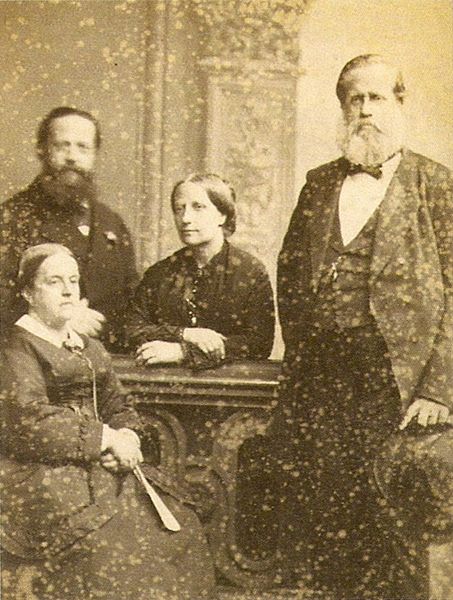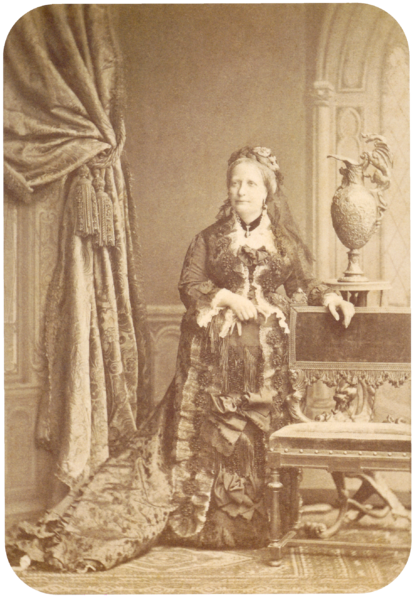<Back to Index>
- Archaeologist Jens Jacob Asmussen Worsaae, 1821
- Painter Jules Joseph Lefebvre, 1836
- Empress Consort of Brazil Teresa Cristina of the Two Sicilies, 1822
PAGE SPONSOR
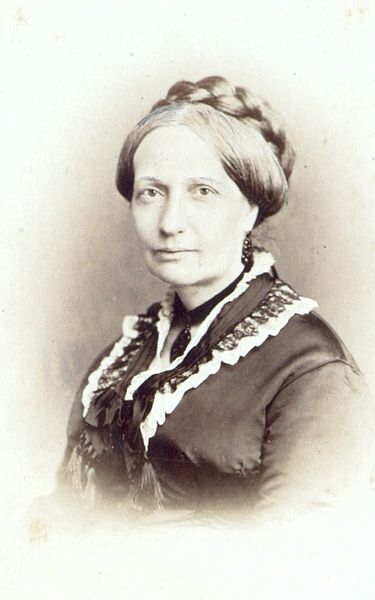
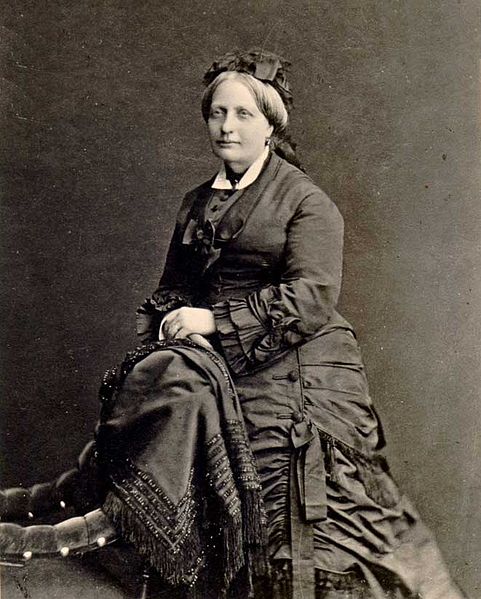
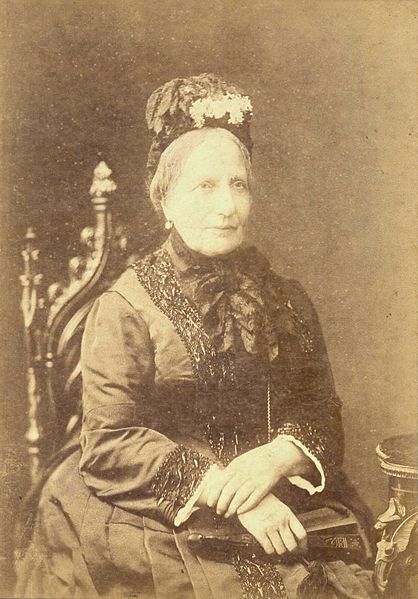
Dona Teresa Cristina (14 March 1822 – 28 December 1889), nicknamed "the Mother of the Brazilians", was the Empress consort of Emperor Dom Pedro II of Brazil, who reigned from 1831 to 1889. Born a Princess of the Kingdom of the Two Sicilies (also known as the Kingdom of Naples) in present day southern Italy, she was the daughter of King Don Francesco I (Francis I) of the Italian branch of the House of Bourbon, called Bourbon - Two Sicilies or Bourbon - Naples, and his wife Infanta Doña Maria Isabella of Spain. Her father died when she was young, and she was neglected by her mother. It was long believed by historians that the Princess was raised in an ultra conservative, intolerant atmosphere which resulted in a timid and unassertive character in public and an ability to be contented with very little materially or emotionally. Recent studies revealed a more complex character, who despite having respected the social norms of the era, was able to assert a limited independence due to her strongly opinionated personality as well as her interest in learning, sciences and culture.
The Princess was considered past her prime when, at the age of 21, she was married by proxy to the 17 year old Brazilian Emperor Pedro II. Her spouse's expectations were disappointed upon meeting his bride, who lacked beauty, in person. Despite a cold beginning, the couple's relationship improved as time passed, due primarily to Teresa Cristina's patience, kindness, generosity and simplicity. These traits also helped her win the hearts of the Brazilian people, and her distance from political controversies shielded her from criticism. She occupied her time writing letters, reading, doing needlework, and attending to religious obligations and charitable projects. The Empress also sponsored archaeological studies in Italy and Italian immigration to Brazil.
Pedro II fell out with Teresa Cristina's brother Luigi, the Count of Áquila, as a result of a personality clash that was exacerbated by the young Emperor's immaturity and insecurity. Pedro II eventually grew to become self assured and independent, which helped improve the couple's relationship and interactions. Even so, the marriage between Teresa Cristina and Pedro II never became passionately romantic, although a bond based upon family, mutual respect and fondness did develop. The Empress was a dutiful spouse and unfailingly supported the Emperor's positions and never interposed with her own views in public. She remained silent on the topic of his suspected extra marital relationships — including a liaison with her daughters' governess. In turn, she was treated with unfailing respect and her position at Court and home was always secure. Of the four children Teresa Cristina bore him, two boys died in infancy and a daughter of typhoid fever at the early age of 24.
Teresa
Cristina not only witnessed the Empire's expansive political and
economic development during the reign of her husband, but also its
downfall. She, along with the remaining members of the Imperial Family,
was sent into exile after a coup d'état staged by a clique of
army officers. Being cast from her beloved adopted land had a
devastating effect on Teresa Cristina's spirit and health. Grieving and
ill, she died of respiratory failure leading to cardiac arrest little
more than a month after the monarchy's collapse. She was greatly loved
by her subjects, both during her lifetime and afterwards. She was even
respected by the Republicans who overthrew the Empire. Despite having
had no direct impact on Brazil's political history, Teresa Cristina is
well regarded by historians not only for her character and
irreproachable behavior, but as well for her sponsorship of Brazilian
culture. Teresa Cristina was the daughter of the then Duke of Calabria,
who later became King Francis I of the Two Sicilies. Through her
father, she was a member of the House of Bourbon - Two Sicilies, the
Italian branch of the Spanish Bourbons. She was a descendant of
France's "Sun King", Louis XIV in the male line through his grandson, Don Felipe V (Philip V) of Spain. Teresa Cristina's mother was the Infanta Doña Maria Isabella, daughter of King Don Carlos IV (Charles IV) of Spain, and a younger sister of Doña Carlota Joaquina — who married King Dom João VI of Portugal and was thus the paternal grandmother of Teresa Cristina's future husband. Born on 14 March 1822 in Naples, Teresa
Cristina became an orphan when her father died in 1830. Her mother is
said to have neglected her after marrying a young officer in 1839. Historiography
has long asserted that she was raised in lonely isolation, in an
environment of religious superstition, intolerance and conservatism. It has also described Teresa Cristina as a soft and timid character, unlike her ruthless father or her impulsive mother. She has even been depicted as unassertive, and accustomed to be satisfied in whatever circumstances she found herself. Some
historians have more recently held to a modified view of both the
Neapolitan Bourbon court as a reactionary regime and of the extent of
Teresa Cristina's passivity. Historian Aniello Angelo Avella states
that the maligned interpretation of the Neapolitan Bourbons traces its
origin to perspectives generated during the 19th century il Risorgimento (Italian unification) following the 1861 conquest of the Kingdom of the Two Sicilies by the Kingdom of Sardinia. Teresa
Cristina is revealed in her personal papers as a strong headed
character. She "was not a submissive woman but instead a person who
respected the roles imposed by the ethics and values of her own times." Physically, she had brown eyes, dark hair, was short, a bit overweight, walked with a pronounced limp and, while not ugly, neither was she pretty. According
to historian Pedro Calmon, Teresa Cristina had no true limp, but her
odd way of walking was instead the result of bowed legs causing her to
lean alternately right and left as she walked. She possessed a beautiful voice, which led her to often practice her singing skills and musical appreciation allowed her to enjoy opera and balls.
Vincenzo Ramirez, minister of the Kingdom of the Two Sicilies, met in
Vienna with
a Brazilian envoy who had been unsuccessfully seeking a bride for his
Emperor, the young Pedro II. The European royal houses which had
been approached were wary, fearing that Pedro II might develop an
erratic personality similar to that of his father, Emperor Dom Pedro I, who was also notorious for his infidelities. Ramirez seemed unconcerned and offered the hand of Teresa Cristina. Romantic
attachment was secondary in an age in which the role of a royal consort
was to bear heirs for her husband and nation. As a princess, eligible
suitors were very limited, and the prospect of marrying an emperor was
an opportunity not to be passed. The
government of the Two Sicilies sent Pedro II a painting depicting
a beautiful young woman, which prompted him to accept the proposal. The Emperor was charmed by the portrait, saying that its subject appeared to be a "fairy princess". According
to historian James McMurtry Longo, the woman portrayed in the painting
was not Teresa Cristina, but someone else, and by the time Pedro II "discovered the deception, it was too late." Because of complicated royal intermarriages, Teresa Cristina was related to Pedro II in many degrees of consanguinity, which required a dispensation from Pope Gregory XVI before the marriage arrangements could be finalized. The permission was obtained, and a proxy wedding was held on 30 May 1843 in Naples, Pedro II being represented by his fiancée's brother Prince Leopold, Count of Syracuse. A small Brazilian fleet composed of a frigate and two corvettes departed for the Two Sicilies on 3 March 1843 to escort the new Empress of Brazil. The Brazilian squadron, accompanied by a Neapolitan naval division consisting of a ship of the line and three frigates, returned to Rio de Janeiro with Teresa Cristina on 3 September 1843. Pedro II
immediately rushed to board the ship and greet his bride. Upon seeing
this impetuous gesture, the crowds cheered and guns fired deafening
salutes. Teresa
Cristina fell in love with her new husband at first sight. He was tall,
well proportioned, blond, blue eyed, and considered handsome in spite of a protunding jaw inherited from his Habsburg ancestors.
The 17-year old Pedro II was, for his part, clearly and greatly disappointed. In his eyes, Teresa Cristina seemed much older at 21 — an age at which women of that era were deemed to be old maids. His
first impressions were only of her physical flaws — and of how much her
appearance differed from the portrait which had been sent to him. His
high expectations were crushed, and he allowed his feelings of
revulsion and rejection to show. One account has him needing to sit due
to shock, while another has him turning on his heel and leaving.
Historian Roderick J. Barman observed that "he may have done both these
things." After
a short interval, he left the ship and she returned to her cabin.
Perceiving his disillusionment, she burst into tears, lamenting that
"the emperor did not like me!" Teresa
Cristina learned that evening that the Emperor had based his
expectations on a picture which did not accurately portray her. Teresa
Cristina was despondent, although she hid her anguish from her husband
and their subjects. She resolved to make the best of the situation, and
wrote home: "I know my appearance is different from what has been
announced. I will make every effort to live in such a way that nobody
will be misled by my character. It will be my ambition to resemble the
nature of Dona Leopoldina, my husband's mother, and to be a Brazilian with all my heart in everything I do." Although
a proxy marriage had already been performed, an extravagant state
wedding was held on 4 September at the cathedral in Rio de Janeiro. Brazil's
new Empress won over her adopted countrymen with her pleasant
disposition and earnestness. In the days following her arrival, she
received expressions of affection and delight from every quarter — except
from her new husband.
One
of the main purposes of a monarch's marriage was to provide a
successor, and the announcement of a pregnancy was anxiously awaited.
As months dragged on without an announcement, people began to speculate
as to reasons for the delay, including questioning the Emperor's
potency. The
true reason was quite different: the Emperor had formed a dislike for
his bride and had no wish to consummate the relationship. Teresa
Cristina eventually asked to be sent back to her father in Italy. Pedro
relented in the face of her obvious misery and marital relations
finally commenced. Even so, Pedro II continued to treat his wife
coldly and subjected her to many slights. Luigi, the Count of Áquila and Teresa Cristina's younger brother, had traveled with her to Brazil. He had married Pedro II's sister and heir, Januária, following Teresa Cristina's own marriage. Pedro II
and his brother - in - law did not get along, and by mid July, they had
stopped speaking to each other. The Count's outgoing personality
conflicted with the Emperor's introversion, and a penchant for
frivolous pleasures offended Pedro II's sense of duty and
propriety. Januária was enamoured of her new husband, and the contrast between the two
couples irritated the Emperor further and highlighted his insecurity
and immaturity. That both Januária and Teresa Cristina got along
well with Áquila only compounded the Emperor's alienation. The
Neapolitans who had accompanied the bridal party to Brazil sought to
carve out positions for themselves. Áquila's confessor was seen
as inflaming the Count's ambitions; encouraging him to create his own
faction among the courtiers. Paulo Barbosa da Silva (the palace
steward) was alarmed by this. He, along with Aureliano de Sousa e
Oliveira Coutinho, Viscount of Sepetiba, had formed a group known as
the "Courtier Faction" which was composed of high ranking palace
servants and notable politicians. They
had exercised a strong influence over Pedro II for years and had
no intention of allowing rivals to challenge their positions. The
Courtier Faction began to exploit the family rift to its own advantage.
The courtiers falsely insinuated that Áquila was cultivating a
bloc plotting to seize the throne. The insecure young Emperor was
inclined to accept this as fact, and the Count began to be slighted and
excluded at court. Áquila reacted by openly complaining of the
lack of consideration and respect being given to himself, and went on
to contemptuously deride society and life in Brazil. Luigi requested
repeatedly that Pedro II grant him leave to travel to Europe. When
he and the Emperor publicly quarreled over the matter at a state
banquet, permission was quickly granted to avoid a public scandal. The
Count of Áquila and Januária set sail from Rio de Janeiro
for Europe on 23 October 1844.
Although
the marriage had been strained from the beginning, Teresa Cristina
continued striving to be a good wife. Her constancy toward fulfilling
her duty, along with the birth of children, softened Pedro II's
attitude. The two discovered shared interests, and their concern for
and delight in their children created a sense of family happiness. That
they were sexually active and compatible is witnessed by the series of
pregnancies which ensued. After the birth of their first son in
February 1845, the Empress bore children in July 1846, July 1847, and
July 1848 — named Afonso, Isabel, Leopoldina and Pedro, respectively. The births stopped after July 1848. Four years of continual pregnancy may be part of the reason for the change. Another
factor may have been the early death of her eldest child, Afonso, in
June 1847. Upon the death of her youngest son Pedro in January 1850,
there were only two daughters remaining as heirs to the throne.
Although the Constitution allowed a female to succeed under male preference primogeniture,
the prevailing attitude at the time was that only a male was capable of
exercising authority over the nation. Teresa Cristina was aware of her
obligation to produce a male heir, and as a dutiful wife never gave any
indication of resisting her role. Aside
from the tragedies, another likely reason for the halt to childbearing
is because the Emperor was becoming more attracted to other women who
possessed beauty, wit and intelligence which the Empress could not provide. Teresa
Cristina had grown to be a vital part of Pedro II's family life
and routine. She never filled the roles of romantic lover or
intellectual partner, however. Her devotion to the Emperor remained
firm, though she feared being supplanted. She
continued to appear with the Emperor in public, and he continued to
treat her with respect and consideration. She was not rejected or
slighted, but the relationship had changed. Pedro II treated her more
as a close friend and companion than as a wife. The
long held view is that the Empress accepted the circumscribed role in
which she found herself, and that her life, duty and purpose were tied
to her position as the Emperor's wife. However,
her personal letters reveal that she could be strongheaded, sometimes
at odds with her husband, and who had a life of her own — albeit
somewhat
restricted. In a letter written on 2 May 1845 she stated: "I wait for
the moment when we will meet, good Pedro, and seek forgiveness for all
that I did to you during these days." In another letter of 24 January
1851, she acknowledged her difficult temperament: "I am not irritated
at you [Pedro II] and you should forgive me because this is my
character." Her friendships were limited to her ladies - in - waiting, and in particular Dona Josefina da Fonseca Costa. She
was well liked by her attendants, a good judge of the character of
visitors and courtiers, unpretentious, generous, kindly and an
affectionate mother and grandmother. She dressed and acted modestly,
only wearing jewelry for occasions of state, and gave the impression of
being somewhat sad. She
had no interest in politics and occupied her time writing letters,
reading, doing needlework, and attending to religious obligations and
charitable projects. Teresa
Cristina did not lack intellectual interests, and she had developed
passions for the arts, music and archaeology — especially the latter.
The
Empress began assembling a collection of archaeological artifacts from
her earliest days in Brazil, and she exchanged hundreds of others with
her brother, King Ferdinand II. She also sponsored archaeological studies in Italy and many of the artifacts — dated from the Etruscan civilization and Ancient Rome times — found were brought to Brazil. The
Empress also aided in recruiting Italian physicians, engineers,
professors, pharmacists, nurses, artists, artisans and qualified
workers with the goal of improving public education and public health
in Brazil.
Pedro II
changed considerably in the period between the departure of
Áquila and Januária in 1844 and the birth of his last
child in 1848. He was more mature and confident, and no longer gave
credence to allegations of plots against him. He learned to detect attempts at manipulating his decisions and rejected partisan
influence peddling. With
growth, the Emperor's weaknesses faded and his strengths of character
came to the fore. He learned to be not only impartial and diligent, but
also courteous, patient and personable. He began to fully exercise
authority, and his new social skills and diligence in government
greatly enhanced his effectiveness and public image. He
tamed his emotions, never losing his temper or displaying rudeness in
public, and was "exceptionally discreet in words and cautious in
action." In time, even the breach with Áquila was smoothed over. Most
importantly, this period saw the fall of the Courtier Faction.
Pedro II quietly and decisively engineered an end to the power
held by the courtiers — all of whom Teresa Cristina strongly disliked — by barring their access to his inner circle. The
relationship between Teresa Cristina and Pedro II never became
passionately romantic. However, a bond based upon family, mutual
respect and fondness did develop. The Empress was a dutiful spouse and
unfailingly supported the Emperor's positions. She was silent on the
subject of his relationships with other women, suspected or otherwise.
In turn, she was treated with utmost respect and there was no question
of her position ever being threatened or called into question. Teresa
Cristina found ignoring her husband's secret infidelities — hidden from
the public, though not always from the Empress — more difficult after
Pedro II named an aia (governess) for their daughters on 9 November 1856. The person chosen was Luísa de Barros, Countess of Barral, the Brazilian born wife of a French nobleman. Barral
possessed all the traits which Pedro II most admired in a woman:
she was charming, vivacious, elegant, sophisticated, educated and
confident. Charged
with the education and upbringing of the young princessess, Barral soon
captured the hearts of both Pedro II and his eldest daughter,
Isabel. Leopoldina was not won over and disliked the Countess. Although Barral "may not have escaped Pedro II's embraces", she "certainly avoided his bed." Nonetheless,
the Emperor's infatuation with the Countess sometimes put Teresa
Cristina in an awkward position, as when her younger daughter
Leopoldina naively asked her why Pedro II kept nudging Barral's
foot during their class. The
Countess's increasing intimacy with her husband and daughter was
painful and vexing to Teresa Cristina. Although she feigned ignorance
of the situation, it did not pass unnoticed. She wrote in her diary
that Barral "wished to make me tell her that I did not like her, but I
did not say either yes or no." Historian Tobias Monteiro wrote that the
Empress "could not disguise that she detested Barral." To someone with Teresa Cristina's character, it must have been difficult
to accept the situation. Leopoldina wrote about her in 22 October 1866:
"Mommy is a very good person, but she is kind of dominating, likes
everything to go only the way she wants, although God in the gospel
says that the woman owes submission to the husband."
The years passed and Teresa Cristina's daughters matured. Isabel and Leopoldina were married to Princes
Gaston of Orléans (the Count of Eu) and August of Saxe - Coburg - Kohary, respectively, at the end of 1864. The
newlywed couples moved on to new lives, and their governess, the
Countess of Barral, returned in March 1865 to France, where she had
lived prior to being appointed to oversee the princesses. Leopoldina died of typhoid fever on 7 February 1871, which was devastating to the small Imperial Family. Pedro II
decided on a trip to Europe that same year in order to, among other
reasons, "cheer up" Teresa Cristina (as stated in his own words) and to
pay a visit to Leopoldina's four small boys. The Imperial couple would travel abroad again during 1876 and 1887. Teresa
Cristina did not seem to enjoy traveling, and the trips did not
distract her. She preferred her ordinary life in Brazil, "devoting
herself to her family, religious devotions, and charitable works." In
fact, visiting her native land only served to resurrect painful
memories. Her family had been dethroned in 1861 and the Kingdom of the
Two Sicilies had been annexed to what would later become the unified Kingdom of Italy.
Everyone she had known from her youth was gone. As she wrote in 1872:
"I do not know how to tell what was the impression I had upon seeing
again, after 28 years, my fatherland and not to find anyone for whom I
cared." Pedro II
and Teresa Cristina brought with them, after their first trip to Europe
in 1872, the two oldest of Leopoldina's children: Pedro Augusto and Augusto Leopoldo.
They were to be raised by the Imperial couple as possible heirs, since
Isabel was then childless (until the birth of her first child in 1875). By the 1880s, Teresa Cristina even seemed to "have become more assertive with her spouse on personal matters". Pedro
II reveals in a letter written to the Countess of Barral in early 1881
that: "The [container] with the earrings which you mentioned, has been
the cause for much recrimination on the part of someone [Teresa
Cristina] who thinks that I have been to blame for their disappearance." Her
son - in - law, Gaston of Orléans, the Count of Eu, wrote his
father
a letter recounting how she had accidentally broken her arm in October
1885: "On Monday 26 when crossing the library on the way to dinner with
the emperor who as usual preceded her by a few steps (and with whom, I
infer from what she told us, she was arguing as she sometimes does),
she caught her foot in a file under a table and fell down flat face
forward." Time passed, and the old couple still behaved as ever. Nonetheless, she continued to express undiminished love for her husband. The
tranquil domestic routine ended when an Army faction rebelled and
deposed Pedro II on 15 November 1889, ordering the entire Imperial
Family to leave Brazil. Although the nation was in the midst of an unparalleled period of economic progress and its international reputation had never been better, from the early 1880s the monarchy had been allowed to become increasingly undermined. The
main causes can be attributed to Teresa Cristina's husband, who had
long ceased to desire a continuation of the monarchy in Brazil. He
allowed Imperial authority to be steadily eroded, allowed the rise of
discontentment among former slaveowners who resented the abolition of slavery in 1888 and
did nothing to suppress insubordination among those military officers
who had openly advocated the creation of a dictatorial republic. Upon
hearing the order to depart, an officer told the Empress: "Resignation,
my lady." She replied to him: "I have it always, but how not to weep
having to leave this land forever!" The
fall of the Brazilian monarchy had a crushing effect on Teresa
Cristina's spirit. According to historian Roderick J. Barman, the
"events of November 15, 1889, broke her emotionally and physically."
The Empress "loved Brazil and its inhabitants. She desired nothing more
than to end her days there. Aged 66 and plagued by both cardiac asthma
and arthritis, she now faced the prospect of accompanying her husband
in unceasing movement across the face of Europe, spending her last
years virtually alone in alien and uncomfortable lodgings." Having
been ill during almost the entire voyage across the Atlantic, Teresa
Cristina and her family arrived in Lisbon, Portugal, on 7 December. André Rebouças,
a renowned Brazilian abolitionist leader, who of his own free will had
accompanied the Imperial Family into exile, wrote in his diary that he
had to awaken at 3:30 during the night "to help the empress, who was
crying due to a most painful attack of asthma."
From Lisbon the Imperial couple went on to
Porto. Isabel and her family, as well as Pedro Augusto, departed to Spain. On
24 December, the Imperial Family received official news that they had
been banished forever from the country. Up until that point, they had
only been requested to leave with no indication as to how long they
were to stay away. The "news broke D. Teresa Cristina's will to live." Pedro II
wrote in his journal on 28 December 1889: "Hearing the Empress complain
I went to see what it was. She is cold with a pain in her sides; but
she does not have any fever." She was not thought to be near death, so her requests for a priest went unheeded, and
Pedro II went out on tour of the town. With no family to attend
her and with little company, Teresa Cristina's breathing became
increasingly labored, and the failure of her respiratory system led to
cardiac arrest and death at 2:00 pm. As she lay dying, Teresa Cristina said to Maria Isabel de Andrade Pinto, Baroness of Japurá (sister - in - law of Joaquim Marques Lisboa, Marquis of Tamandaré): "Maria Isabel, I do not die of illness, I die of sorrow and of regret!" Her
last words were: "I miss my daughter and my grandchildren. I can not
embrace her for the last time. Brazil, beautiful land... To there I can
not return..." According to historian Lídia Besouchet, a "huge crowd" gathered in Porto to witness her funeral. By request of her husband, Teresa Cristina's body was carried to the Church of São Vicente de Fora near Lisbon, where it was interred in the Braganza Pantheon. Her
remains, along with Pedro II's, were later repatriated to Brazil
in 1921 with much fanfare and pomp. They were given a final resting
place in the Cathedral of Petrópolis in 1939. It
came almost as a surprise that the person who suffered the most from
Teresa Cristina's death was Pedro II himself. According to historian José Murilo de Carbalho, despite his "initial
disappointment with the fianceé, her lack of attractiveness, the
love affairs into which he allowed himself be carried, the act of
living together for 46 years ended up generating in him a strong
feeling of friendship and respect for his wife, which her death brought
to the surface." This
opinion is shared by Roderick J. Barman, who said that only "after she
was no more did he begin to appreciate her concern, her kindness, her
self denial, and her generosity. The realization came slowly and with
growing force." He
goes on to say that to "assuage his sense of guilt and to lessen his
deprivation, D. Pedro quickly redefined his mental image of D. Teresa
Cristina, viewing her as 'minha Santa' [my Saint]." She "was now
his superior, surpassing him in virtues. She was enjoying in heaven the
rewards and recognition he had not given her on earth, Her very
sanctitude assured D. Pedro that she had forgiven him his past neglect
and that she would intercede with the Almighty to secure him
forgiveness there too. As a saint she would watch over him and aid him
until he died."
The
news of Teresa Cristina's death produced sincere mourning in Brazil.
Her simplicity, kindness and — especially — her safe distance from
political controversy shielded her from criticism, including from
republicans. The Brazilian poet and journalist
Artur Azevedo wrote
of the general view toward Teresa Cristina after her death: "I never
spoke to her, but also never passed her without respectifuly removing
my hat and bowing myself, not to the Empress, but to the sweet and
honest figure of a poor, almost humble, bourgeoise. I saw many
extremist republicans do the same." He continued: "They called her the
mother of the Brazilians, and we all really attributed to her a kind of
a filial veneration. That is the truth." Azevedo also said that she
"had no enemy. The most violent enemies of the monarchy never insulted
her with the shadow of an allusion, with any semblance of irreverence,
and who knows? Her virtue might have been the strongest sustenance of
this throne, which crumbled another day." She "had the good sense of
never taking part in politics, of never getting involved in State
affairs." And finally: "Her death will be long bewailed: D. Teresa
Cristina was one of those beings whose memory has the right to tears." Newspapers in Brazil also reported her passing. The Gazeta de Notícias (News
Gazette) commented: "Who was this saintly lady, we do not need to
repeat it. All Brazil knows that, in this blow which hurt the former
Emperor profoundly, it is remembered that she was justly and
universally proclaimed the mother of the Brazilians." The Jornal do Commercio (Commercial Journal) wrote: "For forty and six years Dona Teresa
Cristina lived in the Brazilian fatherland which she sincerely loved,
and during that long time never, anywhere in this vast country, was her
name pronounced except in praise and words of regard." It concluded:
"Next to her husband, who was for a long time the head of the Brazilian
nation, her influence was known to be felt only for the good."
Teresa
Cristina has been given a less than prominent place in Brazil's
history. Historian Aniello Angelo Avella said that the Empress,
nicknamed "by her contemporaries as 'Mother of the Brazilians'," is
"completely unknown in Italy and little studied in Brazil". According
to his view, the few existing sources relegate her to having "lived in
the shadow of her husband, dedicating herself to her daughters'
education, to home affairs, to charity." The image which results "is of
a woman of limited culture, blank, silent, who compensated with
kindness and virtues of the heart the lack of physical attributes." And
this is the view that has come to be enshrined in history and the
popular imagination, despite being not quite a true representation of
Teresa Cristina, since she was a well learned and willful woman. According
to historian Eli Behar, she became notable "for her discretion, which
kept her far from being associated with any political movement; and for
her tenderness and charity, which earned her the cognomen 'Mother of
the Brazilians'." A
similar opinion is voiced by Historian Benedito Antunes, who said that
she "was beloved by Brazilians, who defined her, for her discretion, as
the 'silent empress', and yet regarded her as 'the mother of the
Brazilians'." He also praised the Empress for her sponsorship of
cultural and scientific development: she "promoted culture in various
ways, bringing from Italy artists, intellectuals, scientists,
botanists, musicians, thus contributing to the progress and enrichment
of the nation's cultural life." This
view is shared by historian Eugenia Zerbini, who argued that, thanks to
her, Brazil has now the largest classical archaeological collection in
Latin America. Just
prior to his own death, Pedro II donated most of his possessions
to the Brazilian government, which were later divided between the Brazilian National Archives, the Imperial Museum of Brazil, the National Library of Brazil and the Brazilian Historic and Geographic Institute. The exact number of the donated items is still uncertain. The donated materials from the Palace of São Cristóvão alone — the
residence of the Imperial couple — included more than 48,000 bound
volumes, plus collections of photographs, maps, rare manuscripts,
coins, medals, and other effects. It is estimated that more than
100,000 items from the bequest were divided between the National
Library and the Brazilian Historic and Geographic Institute.
Pedro II imposed only one condition: that the gift was to be named
in honor of his late wife, and so it is presently known as the "Teresa
Cristina Maria Collection". The collection is registered by UNESCO as part of the heritage of humanity in its Memory of the World Programme. Finally, Teresa Cristina is remembered in the names of several Brazilian cities, including Teresópolis (in Rio de Janeiro), Teresina (capital of Piauí), Cristina (in Minas Gerais) and Imperatriz (in Maranhão).
